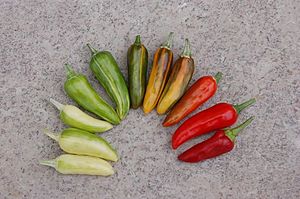Fish pepper facts for kids
Quick facts for kids Fish pepper |
|
|---|---|
 |
|
| Species | Capsicum annuum |
| Origin | Caribbean |
| Heat | |
| Scoville scale | 5,000–30,000 SHU |
The fish pepper is a special type of Chili pepper. It belongs to the Capsicum annuum plant family. This pepper has a cool history, especially with African-American communities in the Chesapeake area. Its leaves are super unique because they have different colors, like white and green stripes! The peppers themselves start white with green streaks, then turn a bright red when they're ready. They can be pretty spicy, ranging from 5,000 to 30,000 on the Scoville scale, which measures how hot a pepper is.
Contents
Where Did Fish Peppers Come From?
The Start of Capsicum annuum
The fish pepper is part of the Capsicum annuum plant family. This plant group also includes many other peppers you might know. Scientists think these peppers first grew in southern Mexico. People in ancient Mesoamerica started growing them around 8,000 BC. From there, they spread across North America and South America. By the time Christopher Columbus arrived, peppers were already growing in the Caribbean.
A Pepper's Journey to the Chesapeake
From the Caribbean, fish peppers traveled to the Chesapeake region. Here, enslaved Africans in Baltimore began to grow them. A food historian named Michael W. Twitty thinks these peppers might have come from Haiti.
By the 1870s, fish peppers became very popular. They were especially loved in the Black communities of Baltimore and Philadelphia. People used them a lot in crab houses and oyster bars. This is how the pepper got its name, "fish pepper"!
Saved from Disappearing
In the early 1900s, as cities grew, fish peppers became less popular. They almost disappeared completely! But in the 1940s, a Black folk painter named Horace Pippin saved them. He lived in Pennsylvania and gave some seeds to a beekeeper named H. Ralph Weaver. In return, Pippin received bee sting therapy for his arthritis.
The Weaver family kept these special seeds safe for many years. Then, in 1995, Weaver's grandson, William Woys Weaver, shared the seeds with the public. He did this through the Seed Savers Exchange Yearbook. Since then, the fish pepper has become popular again. You can now find its seeds on many websites. Some restaurants in the Mid-Atlantic region even use it in their dishes today!
What Do Fish Peppers Look Like?
Fish peppers are known for their bright and changing colors. They can be green, orange, brown, white, and red. They are also quite spicy!
What makes these plants really special are their leaves. The plants grow about 2 feet (60 cm) tall. Their leaves have amazing white and green patterns. This makes them perfect for planting in gardens, both for eating and for looking beautiful.
As fish peppers grow, their color changes a lot. They start out a creamy white. Then, as they get ripe, they turn a bright red. Most fish peppers are hot, with their spiciness ranging from 5,000 to 30,000 on the Scoville scale. The peppers themselves are usually about 1.5 to 2 inches (3.8 to 5 cm) long.

